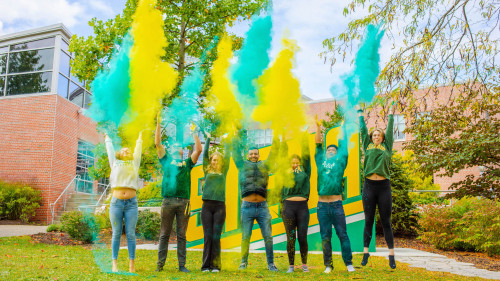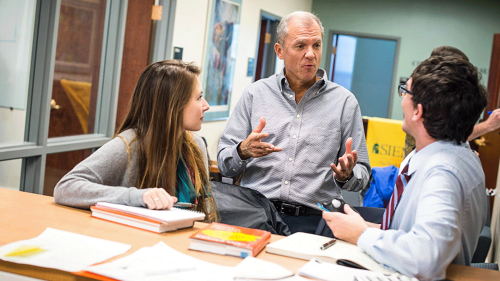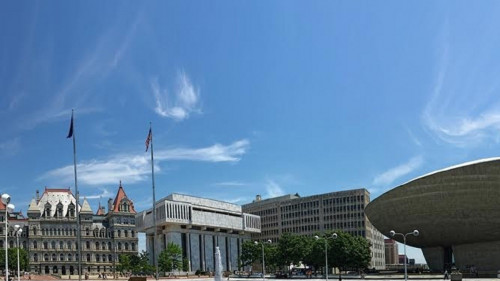
College is so much more than just classes, reading and papers. Research is a seriously big part of higher education. Siena undergrads are pursuing their passions, innovating, creating and learning new skills outside the classroom. For many high school students, the idea of research may still be a little unclear. That’s where we come in. We’re uncovering the mysteries of what research really means and why it’s some of the most impactful learning you’ll do in college.
Follow along as we meet some of Siena’s research students and chat about their awesome project. We’ll explain what they’re actually doing when they’re “researching” and how opportunities for real-world learning abound at Siena. (In fact, these summer researchers were paid for their work, thanks to funding and support from Siena’s renowned Center for Undergraduate Research and Creative Activity, aka CURCA.)
Today, we’re looking at virtual reality and history—and what these students are doing could change museum culture as we know it.
 Meet the Students
Meet the Students
Chris Fall and Matt Pigliavento are computer science majors. Taylor Flach and Shelby Crespino are history majors. Derek and Mike are also majoring in computer science.
Together, they spent their summer months bringing history alive again through virtual reality. How? Check it out.
Virtual reality, computer science and history? What’s your project about?
CHRIS: We’re making a virtual reality app, so you can sort of walk around the Stephen and Harriet Myers Residence in Albany, known as a headquarters for Underground Railroad activity in the mid 1850s. The historians on this project have enabled us to do that by giving us pictures. Our part is creating a virtual reality world where you can walk through the first floor of the house, interact with some pieces (which Taylor and Shelby have been researching) that look historically appropriate, as far as what type of material they were made out of or their size.
SHELBY: The virtual reality guys needed images for their models to create likenesses of them, so we researched period-appropriate pieces and provided them with images. They also have needed a little bit of background information about the house, the residence and the residents who lived there. Anything that they need, we research it for them. Some of the things in [the VR], like some of the chairs, are very close to the chairs that they have at the house right now. And some of them are from a museum that Taylor’s been researching. He’s been sending us pictures and descriptions of what things might have looked like in that time period. As far as the curtains go, those curtains aren’t actually at the house right now, but from archives, we’ve been able to figure out that these are the curtains that they would have had in the 1850s. They actually provided us with an original of what they thought the wallpaper would have looked like, and we were able to give it to a graphics arts student. He recreated it to apply it to the wall, so it looks like the wallpaper that was there.
So how do you use the Virtual Reality app?
MATT: We’ve got two different versions. One of them is a virtual reality where we’ll use a headset and controllers. You can put it on and you feel like you’re there. You feel everything. You can teleport around the room with the controllers, and you can reach out and pick up things that we’ve decided that are tangible to pick up—like a book on a desk, you can examine it closer. But the other version is just for desktop users on the computer. You use one hand to control your forward, backward, left, right. Eventually, we’re hoping that you can click on things to explore them further.
What do you hope will happen with this project in the future?
MATT: Right now, we’re researching interactivity. Maybe next year, to advance this, when you get close to something, a text box pops up or an audio starts to play and it actually describes what this piece of furniture was or piece of artwork was that’s on the wall.
CHRIS: The people in charge of the Underground Railroad History Project and the house are going to see what we’ve got. They’re going to give us some feedback and maybe we can make adjustments according to what they think, or if we can implement some of this interactivity that we’re looking into right now with the sound, the text boxes, any of that—we’d love to. It’s very quiet. You can go through. You can pick things up. You can look at them. But you don’t really have any context. It would be really cool if you could pick up a book or a lamp and hear something along with it.
How did you all come together and get involved with this project?
CHRIS: We took a graphics class with Dr. Flatland, and she emailed us, reaching out to see if we would be interested in this.
TAYLOR: The head of the history department asked me if maybe I’d be interested in an internship opportunity that was available to all history students.
SHELBY: The head of the history department is Dr. Dorsey and I’ve done research with her in the past, during my freshman year, that also had to do with the Underground Railroad house. And I was actually away at a different internship in Fort Ticonderoga. She knew I was coming back around this time and was like, “Hey, if they need extra hands, do you want to help out? You’ve seen it before. Do you want to do something with it now?” And I said, yes. So here I am!
DEREK: We took a class with Dr. Small, one of our computer science professors. And we (me and Mike) both got an email about it. We’re helping Chris and Matt develop some of the models on screen.
What new skills have you learned through this research?
MIKE: When we first got here, we had to learn how to use Blender. So, we went through a tutorial that took us a couple of days. We’ve also gone through some Unreal tutorials.
DEREK: Unreal Engine is a game engine. It’s used to develop video games, mostly in virtual reality software. We’ve been using it to make the virtual world.
CHRIS: We had no background with this. Matt knew a little bit of Blender, I think, but I had no idea. We had to teach ourselves a lot of what we’re doing with online tutorials and articles.
SHELBY: We learned how to organize everything really efficiently. I came into this project three weeks after they had already started it. Taylor had done a lot of the research beforehand, so I spent the first few days kind of catching up. It really made me get organized and really plan out what I was going to do when. Organizational skills were a big factor for me especially.
TAYLOR: I was able to develop and hone my research skills, and I was given the opportunity to work closely with a historical residence which is huge for my field and my work experience.
Why do you think research is such an important experience in college?
CHRIS: Because you actually get to learn hands-on about your fields. It’s sometimes difficult to connect the classroom to the workplace. With something like computer science and programming, it’s just been really cool to apply some of the skills and some of the methodology we’ve learned in our various classes. It’s a valuable experience that way.
MIKE: You get to learn something that’s not part of your major. Developing models isn’t something that I would have to take, but it’s nice to get a broad range of [skills] that are all related back to my major.
Why do you think Siena is such a special place?
SHELBY: It’s a very homey place. And it’s just a very inclusive environment, too. You never feel like you can’t go someplace or you can’t do something or you can’t say something. I’m going to be a senior in the fall, so I’m a freshman orientation leader. I have the opportunity now to work with the freshmen coming in. One of my favorite things about Siena is how you’re incorporated in it right from the beginning. Whether it’s academics...Whether it’s extracurriculars.... Relationships with students on campus or professors.... you can always find a place.
MIKE: I think the smaller size allows you to develop relationships with professors that you wouldn’t get at a larger university. And that helps in the long-run professionally, and it also gives you an opportunity to gain a mentor and develop your skills.
Guys, you’re all amazing. Thank you for chatting with us!
Request more information on Siena College today—and make your goals… actual realities.

